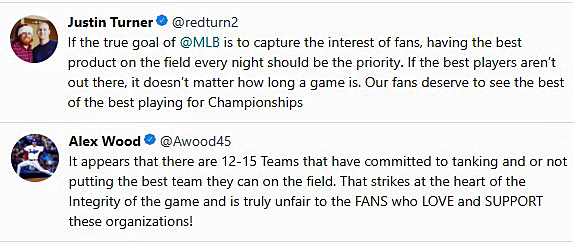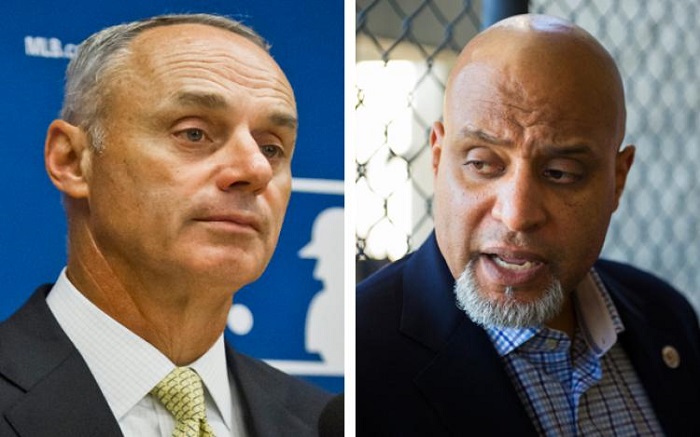According to a September 14, 2017 report released by the U.S Census Bureau, the median income in the United States was $57,617.
According to the Major League Baseball Players Association’s (MLBPA) Collective Bargaining Agreement (CBA), the major league minimum salary in 2017 was $535,000, which will increase to $545,000 in 2018 and to $555,000 in 2019 when the current CBA ends. Keep in mind that these are the MLB minimums, all of which are over a half million dollars.
Brace yourselves baseball fans. According to the MLBPA, the average MLB salary in 2017 (as reported by USA Today on December 27, 2017), was $4,097,122. This was a 3.3 percent increase over the 2016 average MLB salary of $3,966,020.
Now granted, when you consider that there are a grand total of only 750 MLB players in the entire world, you most certainly can understand why these guys are making the kind of money that they are. But still, an average of over four million dollars to play a game?
It doesn’t take rocket science to figure out that if the minimum MLB salary in 2018 is only $545,000 and the average MLB salary in 2017 was over $4 million, somebody (or many somebodies) are getting paid a lot of money. Among those somebodies is Anaheim Angels outfielder Mike Trout who, for the first time under his current 6-year / $144.5 million contract that runs through the 2020 season, will be the highest paid player in the MLB and will make more money than the previous leader – Dodgers ace Clayton Kershaw. Trout will earn $33.25 million in 2018 as compared to Kershaw’s $33 million.
Keep in mind, however, that even though Kershaw’s current 7-year / $215 million contract also runs through the 2020 season, he has an opt-out clause in it at the conclusion of the 2018 season. And while there are some who believe that the soon-to-be 30-year-old (on March 19) three-time NL Cy Young award winner and 2014 NL MVP will forgo his opt-out clause and remain with the only team he has known and the one that drafted him in the first round of the 2006 MLB First-Year Player Draft, ask yourself this: Would you?
This is exactly what former Dodgers right-hander Zack Greinke did following the 2015 season, when he opted out of his contract to sign a 6-year / $206.5 million contract with the Arizona Diamondbacks. As most fans know, Greinke and Kershaw are both clients of noted agent Casey Close.
The point to all of this is that any way you look at it, major league baseball players are paid a lot of money – even at the MLB minimum.
So why, then, did MLBPA executive director Tony Clark – who is fully aware that the current CBA runs through the 2020 season – make this statement on Tuesday afternoon?:
“Pitchers and catchers will report to camps in Florida and Arizona in one week. A record number of talented free agents remain unemployed in an industry where revenues and franchise values are at record highs.
“Spring training has always been associated with hope for a new season. This year a significant number of teams are engaged in a race to the bottom. This conduct is a fundamental breach of the trust between a team and its fans and threatens the very integrity of our game.”
As you might expect, MLB commissioner Rob Manfred responded to Clark’s statement with one of his own:
“Our Clubs are committed to putting a winning product on the field for their fans. Owners own teams for one reason: they want to win. In Baseball, it has always been true that Clubs go through cyclical, multi-year strategies directed at winning.
“It is common at this point in the calendar to have large numbers of free agents unsigned. What is uncommon is to have some of the best free agents sitting unsigned even though they have substantial offers, some in nine figures. It is the responsibility of players’ agents to value their clients in a constantly changing free agent market based on factors such as positional demand, advanced analytics, and the impact of the new Basic Agreement. To lay responsibility on the Clubs for the failure of some agents to accurately assess the market is unfair, unwarranted, and inflammatory.”
But wait, there’s more. You had to know that super agent Scott Boras would chime in on this:
“I find it interesting that free agents have nine-figure offers since the CBA mandates that teams not share that sort of information. I am also curious how a public statement communicated to all teams about offers on the table and players demanding too much money from a central league office … is any different from the infamous ’information bank’ in the 1980s.”
But where things really got ugly and, quite frankly, out of line was when MLB chief legal officer Dan Halem responded to Boras’ comments:
“If Mr. Boras spent as much time working on getting his players signed as he does issuing inflammatory and unsubstantiated statements to the press, perhaps the events of this off-season would be different.”
Shots fired.
But what do the players think about all of this?
By now, every Dodger fan is aware that star closer Kenley Jansen – who himself signed a 5-year / $80 million contract last winter that runs through the 2021 season – weighed in on the subject during the Dodgers annual FanFest event on January 27:
“Maybe we have to go on strike, to be honest with you. That is something we might have to address, so you don’t have a lot of Miami Marlins doing this. Maybe it’s an adjustment for us, as the players’ union. Maybe we have to go on strike, to be honest with you. That’s how I feel about it.”
And then there’s this from Justin Turner and Alex Wood:

Obviously, everyone is entitled to their own opinion on what has clearly become a very heated topic. That being said, if you choose to express yours – at least publicly – just be sure to keep your head down.
…the cannonballs are a flyin.’




 February 7th, 2018 at 10:30 am
February 7th, 2018 at 10:30 am  by Ron Cervenka
by Ron Cervenka 
 Posted in
Posted in 

I fear that this will get uglier as the public rhetoric serves no constructive purpose. First up, pace of play. Will not surprise me for the union to spurn every Manfred proposal to improve pace of play forcing MLB unilateral action, then filing an unfair labor practice for failing to bargain in good faith. Even if the ULP is not upheld by NLRB it sends the message that harmony in the sport/business is over.
Time for Manfred to organize a team made up of owners, players, union management, major league management, some hall of fame members, along with some out of baseball people who can all meet and together work out a new salary contract system that is fair for all players, and owners. Also, the issue of tanking should be addressed and maybe some form of penalties should be put in place to end this practice. The main thing is to get people on both sides talking about how to fix these differences at a table and not in the newspaper or on television.
That is the purpose of collective bargaining. The problem with bringing so many diverse people together for one purpose is that most, if not all, bring with them their own self interests that get in the way of achieving the best possible result. I think Charles O’finley had the solution decades ago as free agency was about to be born, make every player a FA after each season. Sure, it would have been chaos — presently 30 teams signing up to 40 players after every season but in retrospect it was a way for someone like Bellinger to make much more after his rookie season than he will make under the current system, but that would be offset by players like Agon, Pujols, Heyward, Kemp, Price, etc., etc. being offered contracts based upon most recent performance. How motivating would it be to the players that they would be playing every season for next year’s contract.
I guess we should’ve seen this coming with so many bad long term contracts given out and also how successful teams that have tanked had become.